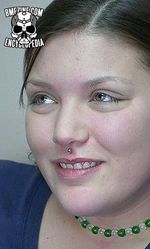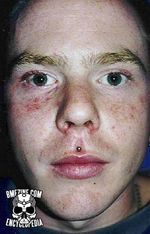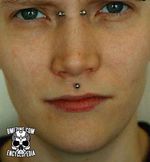Hypertrophic scarring and Medusa Piercing: Difference between pages
(Page conversion via llm-mediawiki-rev -jwm) |
(Page conversion via llm-mediawiki-rev -jwm) |
||
| Line 1: | Line 1: | ||
[[File: | [[File:Medusa Piercing-1.jpg|thumb|right|150px|Medusa Piercing]] | ||
[[File:Medusa Piercing-5.jpg|thumb|right|150px|Medusa Piercing]] | |||
[[File:Medusa Piercing-2.jpg|thumb|right|150px|Medusa Piercing]] | |||
''' | The '''medusa piercing''' is sort of like an upside-down [[Labret Piercing|labret piercing]]. It's a piercing through the center of the upper lip; the philtrum, perpendicular to the tissue. | ||
This piercing was named in the mid 1990s by Kerrick, a hairdresser and model from Toronto, Canada. The piercing was performed by [[Tom Brazda]] of [[Stainless Studios]], although it was certainly not unheard of at that point. It just didn't have a name that had stuck. | |||
This piercing is normally worn with a [[Labret Stud]], although rings and other jewelry are possible. Some people stretch this piercing. | |||
It is important to note that good placement is essential with this piercing. If the placement is not aesthetically balanced, it will accentuate any lack of symmetry in the wearer's face. | |||
=== Alternative Names === | |||
; Philtrum Piercing | |||
: What's interesting is that this is one of the few cases — others include the [[daith]] and [[rook]] — where a decorative name has trumped a proper anatomical name. The [[Philtrum]] is the anatomically correct term for the midline groove of the upper lip which is located between the nose and the top of the lip. | |||
; Cleft Piercing | |||
: This is a local term in Vermont and other areas, with "cleft" referring to the indented space between the ridges above the lip. | |||
; Upbret | |||
: Deviation of ''[[Labret]]''; used in some parts of the West Coast of the United States. | |||
; KA Piercing | |||
: Pronounced "kay - eh", not "kah", this is a term almost exclusively limited to the USENET newsgroup ([[rec.arts.bodyart]]). Rumor has it, it is so named because the piercer [[Keith Alexander]] — a regular in that newsgroup — does not enjoy doing the piercing. | |||
: however... rumors are not always true. Keith wrote in to add, | |||
: : Not true. The term "KA" was coined by [[Yttrx]], then "p0ok", to annoy me. I HATE the bullshit names given to piercings — cindy, madonna, marylin, and especially "medusa." Did the mythical Medusa have such a piercing? I '''love''' doing those, anyway. | |||
It should also be noted that any [[Vertical Labret]] piercing, lower or upper lip, may be referred to as a Medusa in parts of Finland. One reader there writes us,"That caused some confusion for me when I started browsing BME to say the least. I think this originates from the '''[[Harness Studio]]''' in Helsinki, quite probably from a misunderstanding from the time when piercing was taking its first baby footsteps around here." | |||
[[ | === See Also === | ||
* [[Labret]] | |||
* [[Madonna Piercing]] | |||
* [[Horizontal Philtrum Piercing]] | |||
== | === Related Risks === | ||
* [[ | * [[Swollen Lip]] | ||
* [[Embedded Labret]] | |||
Latest revision as of 07:55, 17 September 2023
The medusa piercing is sort of like an upside-down labret piercing. It's a piercing through the center of the upper lip; the philtrum, perpendicular to the tissue.
This piercing was named in the mid 1990s by Kerrick, a hairdresser and model from Toronto, Canada. The piercing was performed by Tom Brazda of Stainless Studios, although it was certainly not unheard of at that point. It just didn't have a name that had stuck.
This piercing is normally worn with a Labret Stud, although rings and other jewelry are possible. Some people stretch this piercing.
It is important to note that good placement is essential with this piercing. If the placement is not aesthetically balanced, it will accentuate any lack of symmetry in the wearer's face.
Alternative Names
- Philtrum Piercing
- What's interesting is that this is one of the few cases — others include the daith and rook — where a decorative name has trumped a proper anatomical name. The Philtrum is the anatomically correct term for the midline groove of the upper lip which is located between the nose and the top of the lip.
- Cleft Piercing
- This is a local term in Vermont and other areas, with "cleft" referring to the indented space between the ridges above the lip.
- Upbret
- Deviation of Labret; used in some parts of the West Coast of the United States.
- KA Piercing
- Pronounced "kay - eh", not "kah", this is a term almost exclusively limited to the USENET newsgroup (rec.arts.bodyart). Rumor has it, it is so named because the piercer Keith Alexander — a regular in that newsgroup — does not enjoy doing the piercing.
- however... rumors are not always true. Keith wrote in to add,
- : Not true. The term "KA" was coined by Yttrx, then "p0ok", to annoy me. I HATE the bullshit names given to piercings — cindy, madonna, marylin, and especially "medusa." Did the mythical Medusa have such a piercing? I love doing those, anyway.
It should also be noted that any Vertical Labret piercing, lower or upper lip, may be referred to as a Medusa in parts of Finland. One reader there writes us,"That caused some confusion for me when I started browsing BME to say the least. I think this originates from the Harness Studio in Helsinki, quite probably from a misunderstanding from the time when piercing was taking its first baby footsteps around here."


